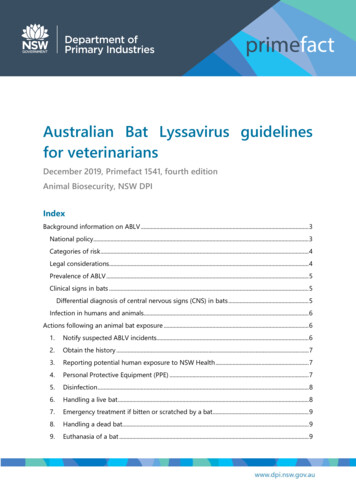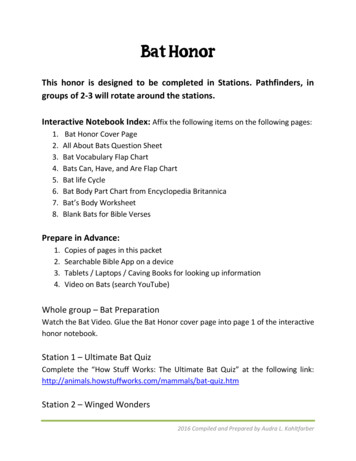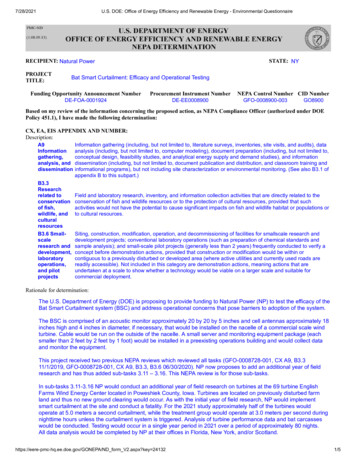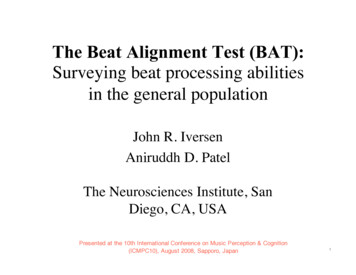
Transcription
Australian Bat Lyssavirus guidelinesfor veterinariansDecember 2019, Primefact 1541, fourth editionAnimal Biosecurity, NSW DPIIndexBackground information on ABLV . 3National policy. 3Categories of risk . 4Legal considerations. 4Prevalence of ABLV . 5Clinical signs in bats . 5Differential diagnosis of central nervous signs (CNS) in bats . 5Infection in humans and animals. 6Actions following an animal bat exposure . 61.Notify suspected ABLV incidents. 62.Obtain the history . 73.Reporting potential human exposure to NSW Health . 74.Personal Protective Equipment (PPE) . 75.Disinfection . 86.Handling a live bat . 87.Emergency treatment if bitten or scratched by a bat. 98.Handling a dead bat. 99.Euthanasia of a bat . 9
Australian Bat Lyssavirus guidelines for veterinarians10.Storage or disposal of a bat carcass . 911.Sample submission. 9a. Submission of the bat for testing. 10b. Packaging diagnostic specimens . 1012.Tests performed . 11Actions based on tests results . 111.Bat tests negative for ABLV . 112.Bat tests positive for ABLV or is not available for testing . 12a. Vaccination . 12b. Euthanasia. 12c. Monitor the animal for at least two years . 12Vaccination of the animal with rabies vaccine . 131. General information. 132. Rabies vaccine . 133. APVMA Permit PER14236 . 144. Rabies Vaccine Control Order . 145. Safety when administering the vaccine . 146. Vaccination protocol – Post-exposure Prophylaxis (PEP) . 157. Collecting serum to measure response to vaccination . 15Animals showing clinical signs consistent with ABLV. 16Responsibility for costs . 16More information . 17Acknowledgments . 172 NSW Department of Primary Industries, December 2019
Australian Bat Lyssavirus guidelines for veterinariansBackground information on ABLVAustralian bat lyssavirus (ABLV) was first identified in 1996 and there is serological evidence ofthe virus in flying foxes/fruit bats (megabats) and microbats. All Australian bat species areconsidered potentially infectious.Human health is an overriding factor in managing all incidents involving potential ABLVinfection of pet animals and their owners.Since November 1996, three people have died as a result of ABLV infection. All three cases hada history of scratches or bites from bats and the affected people were not previouslyvaccinated against rabies. In two of these cases the infected bats showed clinical signsconsistent with ABLV infection.The available data from natural ABLV infection indicates that the incubation period in humansand bats is similar to that of rabies, and is variable from days to years. Death occurs after ashort illness characterised by progressive severe nervous signs. Closely related lyssavirusesoverseas cause illness in a wide range of domestic and wild animals and ABLV infection inadditional animal species is likely to be reported in the future. In 2013, two horses wereeuthanased after being infected with ABLV from bats. Overseas, closely related lyssavirusescause illness in a wide range of domestic and wild animals. It is possible ABLV infection in otheranimals may be reported in Australia in the future.Virus survival outside the host is short and it is inactivated by many disinfectants and soap.Rabies vaccination is thought to provide cross protection against an ABLV challenge.Australian bat lyssavirus (ABLV) is one of sixteen genotypes of lyssavirus which are foundaround the world. Fourteen of these exist in bats but only ABLV is known to occur in Australia.The best known lyssavirus is classical rabies virus.Australia has a current international health status through the World Organisation for AnimalHealth (OIE) of ‘rabies-free’. The presence of ABLV and the use of rabies vaccine does not affectAustralia’s rabies-free status.National policyNational policy and approach to ABLV is presented in the AUSVETPLAN; this containscomprehensive information for the management of animals that have potentially beeninfected with ABLV.It is presumed that if an animal of a non-bat species develops clinical disease due to ABLVinfection, then that animal has the potential to transmit ABLV to humans and other animals.3 NSW Department of Primary Industries, December 2019
Australian Bat Lyssavirus guidelines for veterinariansCategories of riskBats can be categorised based on their potential to transmit ABLV to humans and otheranimals (i.e. potential for an infected bat to have infectious contact with a human or otheranimal). These categories are listed from highest to lowest urgency for action:Category 3 (high human health risk). Bat that is known or reasonably suspected to have hadpotentially infectious contact with a human (e.g. has bitten or scratched a person). WithinCategory 3, bats with clinical signs suggestive of ABLV are of highest risk.Category 2 (high animal health risk, medium human health risk). Bats that potentially pose arisk of infection to humans. Disease investigation and exclusion testing is recommended dueto either: history or clinical signs suggestive of ABLV without a history of a potentially infectiouscontact with a human (Category 2a) history of known or suspected contact with another animal (other animal potentiallyexposed to ABLV via bat) (Category 2b).Category 1 (low risk). Bat that is neither Category 2 nor Category 3 — that is, bat that has nohistory of known or suspected contact with another animal or person and for which the indexof suspicion for ABLV infection is low (e.g. no clinical signs consistent with ABLV).Legal considerationsLyssaviruses (including ABLV) are notifiable under the Biosecurity Act 2015 (the Act). ClinicalABLV in any animals other than bats and exotic genotypes of lyssavirus (including rabies) are listedas Prohibited Matter under schedule 2 of the Act. ABLV in bats is listed as notifiable under Schedule1 of the Biosecurity Regulation.This means that in NSW, a person who owns or is caring for an animal, or a person such as aveterinarian in their professional capacity, has a duty to the following legal obligations: immediately and verbally notify suspected infection to an authorised officer is onlyrequired where they suspect, or is aware, that:o an animal (other than a bat) has clinical ABLVo an animal has an exotic lyssavirus genotype (including rabies).notify an authorised officer within one working day if they suspect, or are aware, that abat is infected with Australian Bat Lyssavirus.Authorised officers include NSW Department of Primary Industries (DPI) or Local LandServices (LLS) staff.The current Australian Pesticides and Veterinary Medicines Authority (APVMA) permit PER14236 outlines the permitted use of rabies vaccine in Australia.4 NSW Department of Primary Industries, December 2019
Australian Bat Lyssavirus guidelines for veterinariansPrevalence of ABLVThe natural reservoir of ABLV in Australia is bats. Wherever bats are located, there is the riskof ABLV infection. Within NSW, positive cases of ABLV in bats have come from across the state.Research indicates that ABLV is a rare infection, estimated to be present in less than 1% of wildbats. However the prevalence in bats submitted to laboratories for ABLV testing (sick, injuredor recently dead bats), is higher. A recent study by Field (2018)1 indicated the prevalence ofcurrent ABLV infection in bats submitted for ABLV testing in Queensland and NSW was 6.8%.1. Field HE. Evidence of Australian bat lyssavirus infection in diverse Australian bat taxa. Zoonoses Public Health.2018;00:1–7. https://doi.org/10.1111/zph.12480Clinical signs in batsBats showing clinical disease caused by ABLV can present with a range of non-specific clinicalsigns that may include one or more of the following: Overt aggression, Paresis and paralysis Seizures, tremors and weakness Respiratory difficulties, change of voice Located on the ground or low in a tree with inability to take off or to fly in a normalmanner Bats in unusual locations during the daytime. i.e. not in normal roostsAll bats should be treated as potentially infectious even if they appear normal.Differential diagnosis of central nervous signs (CNS) in bats Head trauma and Angiostrongylus spp infection ABLV infection.If the course of the illness is longer than seven days and not progressive, angiostrongyliasismay be more likely.All three conditions have a poor prognosis and because of the risks involved, caring for batswith central nervous system signs should be discouraged and it is recommended that the batis euthanased.5 NSW Department of Primary Industries, December 2019
Australian Bat Lyssavirus guidelines for veterinariansInfection in humans and animalsABLV causes meningoencephalomyelitis, which is invariably fatal and is indistinguishable fromrabies in humans and other animals.People are at risk of contracting ABLV if they handle bats without taking precautions.Lyssaviruses are usually transmitted to humans via bites or scratches. This provides directaccess of the virus in saliva to exposed tissue and nerve endings. Exposure to virus in bat salivavia mucous membranes (eyes, nose and mouth) and open wounds (bites, sores) can also occur.ABLV has also infected horses in Australia. There have been no reported cases of ABLV in otheranimals in Australia yet, but the potential is always there. Any bat-animal interaction ispotentially serious. A bat that is found on the ground or in unusual roosting locations has ahigher likelihood of being infected with ABLV. It is unknown if a Lyssavirus positive animal(besides bats) can transfer infection to humans or other animals.There is no effective treatment for ABLV once clinical signs are seen. Prevention by preexposure vaccination or post exposure prophylaxis is the best method. Both these approachesinvolve the use of rabies vaccine.Reports are regularly received by the Animal Biosecurity Emergency Hotline of domestic pets,particularly dogs or cats, coming into close physical contact with bats. This close contact formsa theoretical risk of transmission of ABLV to dogs and cats and theoretically to their owners.Actions following an animal bat exposure1. Notify suspected ABLV incidents if appropriateNotification of exotic lyssavirus in any animal or clinical ABLV in animals (except bats)Immediate verbal notification of suspected infection to an authorised officer is only requiredwhere a veterinarian suspects, or is aware, that: an animal (other than a bat) has clinical ABLVan animal has an exotic lyssavirus genotype (including rabies).In these circumstances call the Emergency Animal Disease Watch Hotline on 1800 675 888.Infection or suspected infection of bats with ABLVVeterinarians must notify an authorised officer within one working day if they suspect, or areaware, that a bat is infected with Australian Bat Lyssavirus. In these circumstances, you cannotify by emailing animal.biosecurity@dpi.nsw.gov.au with details of the case and your contactinformation. Where the bat is being submitted for ABLV testing, please attach a copy of yoursubmission form.6 NSW Department of Primary Industries, December 2019
Australian Bat Lyssavirus guidelines for veterinariansBats that have interacted with other animalsThere is no requirement to notify an authorised officer of an interaction of a bat with anotheranimal, such as a cat or a dog in cases when ABLV infection in the bat is not suspected, evenif you are submitting the bat for testing.NSW DPI Biosecurity & Food Safety staff take a precautionary approach to potential exposuresto ABLV while scientific knowledge continues to be accumulated. This precautionary approachassumes that possible exposures between animals and bats may transmit ABLV to the incontact animals.Further it is assumed that an animal infected with ABLV may progress to develop rabies-likeclinical disease and may then pose a risk of transmitting ABLV to humans and other animals.2. Obtain the historyIt is important to include details such as: Where and when the animal came in contact with the bat. The clinical condition of the bat. If the bat appeared ill at the time of the incident it ismore likely to be infected with ABLV. Is the bat is dead or still alive? If still alive it becomes a priority to provide advice onsafe handling and personal protection. If the client has been scratched or bitten by a bat, NSW Health (phone 1300 066 055)must be informed immediately.3. Reporting potential human exposure to NSW HealthWhen a human/bat interaction has occurred, the person should be advised to immediatelyring their local Public Health Unit (phone 1300 066 055)These bats are described as C3 (Risk Category 3).Advice should be given to isolate the bat or avoid further contact. Wash the affected area withsoap and water (further details under section 7. Emergency treatment if bitten or scratched bya bat).If the bat is available it should be safely kept for testing. NSW DPI is responsible for laboratorytesting of C3 bats.4. Personal Protective Equipment (PPE)PPE should be worn to minimise the risk of exposure to ABLV. It should be selected basedupon the assessed level of risk and the task. PPE may include:7 NSW Department of Primary Industries, December 2019
Australian Bat Lyssavirus guidelines for veterinarians Puncture resistance gloves (e.g. Nitrile gloves (double) or thicker gloves e.g. Kevlar orsuede/leather welding type gloves) Long sleeved clothing and long pants Puncture resistant gauntlets to protect the forearms Safety eyewear or a face shield Towel to hold the batWash hands after contact with bats and removing PPE. All cuts should be covered with a waterresistant dressing.5. DisinfectionThe virus is short lived outside the host being rapidly inactivated by heat, direct sunlight andlipid solvents including soap. It lasts up to 24 hours in saliva but less when unprotected andexposed to the elements.6. Handling a live batLive bats should only be handled by trained people who have received rabiesvaccination.Members of the public are strongly advised not to attempt to handle any bats. They shouldcontact a wildlife care group (such as WIRES 1300 094 737, or other registered groups listedat find-your-nearest-rescue-group/)) whocan then transport these bats to a private veterinarian who normally deals with wildlife.AUSVETPLAN states that ‘Animals potentially infected with Australian bat lyssavirus should beapproached with extreme caution. .Only experienced bat handlers who have been vaccinatedfor rabies should attempt to capture and care for sick or injured bats’.The following precautions should be taken when handling bats: Only vaccinated people with titres 0.5IU/ml should handle bats. Prevent mucous membrane exposure (eyes/mouth) by using PPE. Wear appropriate PPE to minimise risk of significant contact through bites andscratches. Where possible have a vaccinated, experienced bat handler hold the bat whenconducting a clinical examination or euthanasia.8 NSW Department of Primary Industries, December 2019
Australian Bat Lyssavirus guidelines for veterinarians7. Emergency treatment if bitten or scratched by a batIf bitten or scratched, proper cleansing of the wound is the single most effective measure forreducing transmission: Do not scrub the wound. Immediately wash the wound with soap and water for at least 5 minutes. Apply an antiseptic with anti-viral action, such as povidine-iodine, iodine tincture,aqueous iodine solution or alcohol (ethanol) after washing. If saliva enters the eyes, nose or mouth, the area should be flushed thoroughly withwater. Contact your General Practitioner or your local public health unit immediately8. Handling a dead batIf the bat is dead, it should be collected and placed inside a secure and waterproof container.Exposure of skin or mucous membranes to the secretions or excretions of the bat must beavoided. Handling the carcass remotely (e.g. using a garden fork, spade or other implements)and using rubber gloves are recommended methods of preventing direct exposure.9. Euthanasia of a batBats can be euthanased using pentobarbitone solution injected intra-peritoneal. Ideally thisshould be done after the bat has been anaesthetised. To reduce the risk of being scratchedduring euthanasia, the bat can also be placed in a bag and anaesthetised using gaseousinduction.10. Storage or disposal of a bat carcassWhole bat carcasses should be submitted to NSW DPI Laboratory Services as soon as possibleto minimise post-mortem decomposition. They should be double bagged in leak-proof andpuncture resistant bags with a warning label (bat for ABLV testing) affixed to the outer bag.All bat carcasses should be refrigerated only (not frozen) until submission.If a client elects not to submit a dead bat for testing, the carcass must be disposed of by: routine clinic biological waste, or deep burial where dogs cannot dig them up, or check with your local council as to which local council service may be used.11. Sample submission9 NSW Department of Primary Industries, December 2019
Australian Bat Lyssavirus guidelines for veterinariansThe advantage of testing the bat for ABLV is that a negative result will exclude the risk of ABLVtransmission to other animals or humans.Testing is best done on the brain tissue, so it is important to submit whole bat carcasses,including the head. Undertaking autopsy first and submitting tissue specimens is notrecommended because of the risk of exposure or injury to the operator.When to submit a bat to NSW DPI Laboratory Services: In cases of known or probable exposure of an animal to a bat (C2 bat) where a bat shows clinical signs suggestive of ABLV Where there has been known, probable or possible human exposure to ABLV from thebat (C3 bat) NSW Health must be notified too.a. Submission of the bat for testingNSW DPI will pay for the cost of the courier and the laboratory testing for bat submissions.Contact NSW DPI Laboratory Services Customer Service Unit during business hours:Phone: 1800 675 623 prior to submitting any samples for notifiable disease testing.Email: laboratory.services@dpi.nsw.gov.auVisit the NSW DPI Laboratory Services Customer Service webpage for more information.Submission information: Samples can only be submitted by a veterinarian. All sample submissions must have a completed Veterinary Specimen AdviceSubmission Form. Information required includes:1. the location the bat was found, or where the bite/scratch occurred2. Clinical information (e.g. human exposure vs animal exposure), neurological stateof bat, if it was dead or alive upon arrival at the vet clinic, and the method ofeuthanasia.3. Contact details for the submitter4. The name and age of the human exposed.b. Packaging diagnostic specimensPackaging and transport of dead bats needs to meet relevant transport and packagingguidelines (IATA packing instruction). Ensure safety of all personnel involved10 NSW Department of Primary Industries, December 2019
Australian Bat Lyssavirus guidelines for veterinarians Triple bag bat in sealed watertight plastic bag. Ensure sufficient absorbent material toabsorb all the fluid in the first bag. . Indelibly label the secondary container with the owner's name. Put Specimen Submission Form(s) into a separate plastic bag. Put specimens, Specimen Submission Form(s), cooler bricks and tight packing into anesky. Crumpled newspaper will suffice for tight packing. Put a note on top of samples inside the esky ‘Caution ABLV exclusion’ (don't write thison the outside) If the esky is foam, seal it into a cardboard box. Attach the courier consignment note to the outside of the package (NB: NSW DPILaboratory Services CSU will email you the courier consignment note to print out) Make sure the packaging complies with the IATA packing instructions12. Tests performedTwo separate real time PCR assays are run that detect the two known genotypes of lyssavirusfound in bats in Australia (these are the insectivorous and flying fox strains of ABLV). The realtime PCR assays are not only highly sensitive and specific, they are more tolerant of poorsample quality.Testing at Australian Animal Health Laboratory (AAHL) is also done as it offers theimmunofluorescence antibody test (IFAT) test and the results from AAHL are used as averification.It is believed that in theory if there was another strain of lyssavirus present in Australian batsthen the IFAT may detect it more readily if it was genetically very different to the current strains.If a positive is detected on PCR by NSW DPI Laboratory Services, it is recommended thattreatment of the pet commence immediately.Results may be available within 24 hrs and even in 4-5 hours in high risk cases.Actions based on tests resultsSituations occur where the animal may be exposed to more than one bat. The risk ofexposure may not be resolved by testing only one bat. In this situation the veterinarianmay decide to proceed with vaccination of the pet as the disease status of theinteractions is unclear.1. Bat tests negative for ABLV11 NSW Department of Primary Industries, December 2019
Australian Bat Lyssavirus guidelines for veterinariansWhen the bat tests negative for ABLV, there is no risk to the in-contact animal and the nofurther action is required (unless additional exposures may have occurred).2. Bat tests positive for ABLV or is not available for testingIf the bat is available and tests positive or is not available for testing, there is a real risk of thepet owners or other in-contact humans contracting ABLV infection from the pet. To date,transmission from an affected pet to a human has never been reported. Public health guidanceis that the risk of transmission of ABLV from a dog or a cat to a person is very low but the riskexists. If such transmission was to occur, the potential outcomes are obviously extremelyserious as reported cases of ABLV infection in humans have been fatal.Advice to the owner should include the following options:a. VaccinationVaccinate the affected pet with inactivated rabies vaccine as soon as possible after the contactwith the bat to reduce the risks of clinical ABLV infection. This mirrors the current public healthrecommendation for post-exposure treatment of people against ABLV infection. The rabiesvaccine is used on the basis of the limited available animal data and clinical experiencesupporting its use. Vaccinated pets that are known to have had interaction with a positive oran untested bat should be monitored for neurological signs; if these signs develop the affectedanimal should be seen by a veterinarian ASAP.For details of the vaccination protocol, please see section – Vaccination of the animal withrabies vaccine.For the costs associated with vaccination, please see section – Responsibility for costs.b. EuthanasiaTo avoid any potential risk of humans contracting ABLV infection from the pet some ownermay request euthanasia of the pet.c. Monitor the animal for at least two yearsThe pet owner can keep the animal at home but should be advised to observe their pet closelyat least two years for any changes in behaviour or signs of ill-health (due to the possible longincubation period). Any changes should be immediately reported to an authorised officer atLocal Land Services, animal biosecurity or the Animal Biosecurity Emergency Hotline 1800 675888 (any time). The owner needs to also understand that taking no action does nothing tolower the potential risk of ABLV infection. If clinical signs suggesting ABLV disease arereported, it is likely to be recommended that the animal be euthanased and samples taken forexamination.12 NSW Department of Primary Industries, December 2019
Australian Bat Lyssavirus guidelines for veterinariansVaccination of the animal with rabies vaccine1. General informationWhere a bat has interacted with a pet, the bat tests positive or the bat is not available fortesting (including cases of repeat exposure to bats), the owner should be offered the optionof vaccinating the animal/s with rabies vaccine. If the owner is considering the vaccinationprogram, it should be commenced as soon as possible after the bat/animal interaction. Theearlier the vaccine is given to the dog or cat after potential exposure to ABLV (via the bat), theless likely they will develop the disease before the post exposure prophylaxis (PEP) can takeeffect. This will also lower the risk to any dog, cat or humans associated with the animal.If the bat is available for testing, the owner can elect to wait until results are available to beginthe vaccination program.Vaccination should still be administered to healthy animals even if there has been a delay postthe exposure as the vaccine still has the potential to prevent infection. The incubation periodfor natural ABLV infection indicates that the incubation period in humans and bats is similarto that of rabies, and is variable from days to years, but is most commonly 28 – 60 days. Theowner should also be advised that NSW DPI Biosecurity & Food Safety staff will determinefurther action required should the animal/s develop clinical signs of ABLV infection at any time.If a veterinarian suspects clinical ABLV infection of an animal (other than a bat) at any time,they should phone the Animal Biosecurity Emergency Hotline (1800 675 888 24 hours/ 7 days)urgently for advice on the appropriate course of action.The owner is respon
aware, that a bat is infected with Australian Bat Lyssavirus. In these circumstances, you can notify by emailing animal.biosecurity@dpi.nsw.gov.au with details of the case and your contact information. Where the bat is being submitted for ABLV testing, please attach a copy of your submission form.










